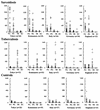Quantitative analysis of mycobacterial and propionibacterial DNA in lymph nodes of Japanese and European patients with sarcoidosis
- PMID: 11773116
- PMCID: PMC120089
- DOI: 10.1128/JCM.40.1.198-204.2002
Quantitative analysis of mycobacterial and propionibacterial DNA in lymph nodes of Japanese and European patients with sarcoidosis
Abstract
The cause(s) of sarcoidosis is unknown. Mycobacterium spp. are suspected in Europe and Propionibacterium spp. are suspected in Japan. The present international collaboration evaluated the possible etiological links between sarcoidosis and the suspected bacterial species. Formalin-fixed and paraffin-embedded sections of biopsy samples of lymph nodes, one from each of 108 patients with sarcoidosis and 65 patients with tuberculosis, together with 86 control samples, were collected from two institutes in Japan and three institutes in Italy, Germany, and England. Genomes of Propionibacterium acnes, Propionibacterium granulosum, Mycobacterium tuberculosis, Mycobacterium avium subsp. paratuberculosis, and Escherichia coli (as the control) were counted by quantitative real-time PCR. Either P. acnes or P. granulosum was found in all but two of the sarcoid samples. M. avium subsp. paratuberculosis was found in no sarcoid sample. M. tuberculosis was found in 0 to 9% of the sarcoid samples but in 65 to 100% of the tuberculosis samples. In sarcoid lymph nodes, the total numbers of genomes of P. acnes or P. granulosum were far more than those of M. tuberculosis. P. acnes or P. granulosum was found in 0 to 60% of the tuberculosis and control samples, but the total numbers of genomes of P. acnes or P. granulosum in such samples were less than those in sarcoid samples. Propionibacterium spp. are more likely than Mycobacteria spp. to be involved in the etiology of sarcoidosis, not only in Japanese but also in European patients with sarcoidosis.
Figures


References
-
- Abe, C., K. Iwai, R. Mikami, and Y. Hosoda. 1984. Frequent isolation of Propionibacterium acnes from sarcoidosis lymph nodes. Zentbl. Bakteriol. Mikrobiol. Hyg. A 256:541–547. - PubMed
-
- Bocart, D., D. Lecossier, A. De Lassence, D. Valeyre, J. P. Battesti, and A. J. Hance. 1992. A search for mycobacterial DNA in granulomatous tissues from patients with sarcoidosis using the polymerase chain reaction. Am. Rev. Respir. Dis. 145:1142–1148. - PubMed
-
- Cummings, M. M., and P. C. Hudgins. 1958. Chemical constituents of pine pollen and their possible relationship to sarcoidosis. Am. J. Med. Sci. 236:311–317. - PubMed
-
- Di Alberti, L., A. Piattelli, L. Artese, G. Favia, S. Patel, N. Saunders, S. R. Porter, C. M. Scully, S. L. Ngui, and C. G. Teo. 1997. Human herpesvirus 8 variants in sarcoid tissues. Lancet 350:1655–1661. - PubMed
Publication types
MeSH terms
Substances
LinkOut - more resources
Full Text Sources
Other Literature Sources
Medical
Molecular Biology Databases
Miscellaneous

